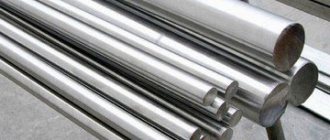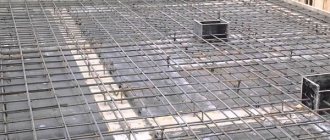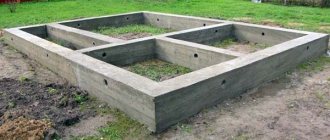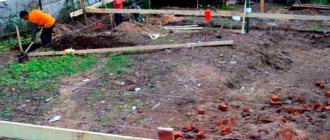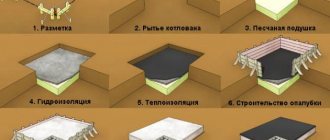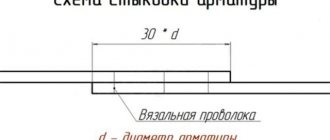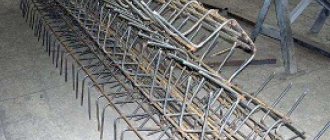The foundation is the support of any object, the strength of which determines its operational life. Reinforcing the foundation slab with steel rods is considered the simplest and most effective option for increasing the service life of the foundation. This technology is very popular when constructing monolithic structures subject to significant bending forces, which can easily destroy simple concrete that does not have a metal frame base.
The need for reinforcement
The reinforcement cage is a necessary element of the slab. Some builders do not do this work, believing that the concrete structure can independently resist load forces. To know exactly why reinforcement of a slab foundation is required, you need to study the problematic issues solved by this element:
- the frame base gives the foundation additional strength, allowing it to withstand greater loads compared to conventional cement slabs;
- simple concrete can withstand compression, but does not withstand bending well. Steel reinforcing bars prevent the slab from bending due to uneven load, which reduces the risk of partial shrinkage of the structure;
- The reinforcement of the foundation slab does not allow it to succumb to deformation during the process of swelling and movement of the soil composition. It should be noted that the reinforced foundation is not afraid of sudden changes in temperature and the effects of ground moisture.
The reinforcement cage increases the service life of not only the foundation, but also the entire facility. The production of frames is regulated by SNIP, which specifies the basic requirements and dimensions of the rods.
Basic reinforcement schemes
When strengthening a slab foundation, the reinforcement scheme is drawn up in strict accordance with technology.
If necessary, this scheme may involve an uneven distribution of rods. Places where it is planned to install load-bearing interior partitions and columns (pressure zones) are subject to additional reinforcement.
The reinforcement is laid in one layer if the thickness of the slab does not exceed fifteen centimeters. In other cases, it is recommended to install a reinforcement cage.
Calculations for a slab-pile foundation are performed separately, taking into account the location of the pile supports and the material from which they are made. In each case of slab reinforcement, the drawing is drawn up according to preliminary calculation data.
Slab parameters
Using a specific example, we propose to consider the main components of the foundation structure. Imagine a grid with identical cells and a constant spacing between the reinforcement bars. According to the calculated load data, the interval between the rods should be from twenty to forty centimeters.
As follows from the rules of building codes, the pitch between the rods should not exceed one and a half times the thickness of the base.
Most often, the reinforcement is laid in two rows, the joint actions of which are ensured by vertical rods. The distance between the rods should be equal to the pitch of the main metal structure. Reinforcement at the ends of the slab is performed with U-shaped clamps; their minimum length is equal to two parameters of the base thickness.
All rows must be covered with rod strapping to ensure reliable perception of torque at the edges of the foundation and to be able to anchor the ends of the longitudinal rods.
The entire frame is recessed in the concrete mixture two to three centimeters on each side. If this condition is not met, the process of metal corrosion accelerates, causing destruction of the base.
Punching zones
At the support points of vertical structures, rods are laid out with a reduced reinforcement pitch. If the rods are laid out across the entire width of the foundation slab in increments of twenty centimeters, then in places where partitions are placed it is recommended to reduce this distance to ten. This will prevent the occurrence of cracks and dents.
If the junction point is on a monolithic basement wall, the laying is carried out to a depth corresponding to the height of the room under construction. In this case, the bases are tied to the walls.
When reinforcing a monolithic foundation, the frame elements of the slabs and walls should be tied together. When concreting the base, it is necessary to leave parts of vertically placed rods, which later act as connecting links. Such ends are launched into the base, the edges are bent at the level of two dimensions of the slab height, then they are tied to the main frame.
Description of reinforcement schemes
Reinforcement along the width of the slab
Most often, reinforcement of a slab foundation is carried out along the main width of the slab using a mesh with the same cell size. When calculating the grid spacing, the size of the foundation and the amount of load it will take upon itself after the building is erected are taken into account. It is possible to use rods of different diameters, with thicker rods placed under the bottom of the structure. It is recommended to use reinforcement along the main width for the lower part of the slab to distribute the load over the entire area.
U-shaped rods are placed in the end parts, connecting the lower and upper reinforcing balls into a single whole. These elements further strengthen the structure, compensating for the destructive effects of torques.
Creating a floor using corrugated sheets
An interesting technology that allows you to create floors with high load-bearing capacity. Profiled sheets N-60/N-75 are suitable for work. The sheets are mounted in such a way that after pouring, ribs are formed at the bottom. The reinforcing mesh is installed on top of the sheet at a distance of 150 mm. A rod with a diameter of 12-14 mm is installed in the ribs; plastic clamps should be used to mount the rods.
Solid slab
This technology is used if it is necessary to create a slab foundation or span with a thickness of no more than 200 mm. The frame consists of two grids located in parallel planes. For installation of meshes, rods with a diameter of 10 mm are suitable. In the middle of the structure, additional reinforcing elements with a length of 40 cm or more are installed in the lower grid. The frequency of installation of reinforcing elements should be equal to the pitch of the main grid.
The support points of the slab must be equipped with additional reinforcement, installing it in the upper part of the structure. The ends of the mesh are also fastened with U-shaped elements combining the segments.
Selection of reinforcement material
Three types of reinforcement are used in construction:
- And 240 – with a smooth surface. It performs reinforcement in vertical planes. It is not used to strengthen monolithic slabs;
- And 300 - the diameter is ten to twelve millimeters. The rods have notches in the form of rings;
- A 400 – rods with a crescent-shaped profile. The working diameter is increased, excellent for reinforcing thick foundation slabs.
Before performing reinforcement, the optimal cross-section of metal rods should be determined. The reinforcing mesh is made up of a pair of layers, its elements are located at right angles towards each other. The bottom and top are connected with clamps.
By specifying the thickness of the concrete, you can determine the diameter of the reinforcement running in one direction. It should reach 0.3% of the total area of the slab.
If one side of the foundation is less than three meters, it is sufficient to use ten-millimeter reinforcement. Thicker slabs are reinforced with rods with a cross-section of twelve millimeters. The maximum percentage of reinforcement for large slabs reaches four centimeters.
Calculation of diameter and quantity of reinforcement
The cross-section of the reinforcing material used to construct a reinforced strip monolithic foundation is considered an important indicator, and it should be determined in advance.
There is a certain technique for this:
- the length of the slab is multiplied by its height to determine its cross-section;
- the permissible diameter of the rod is calculated, for which the cross-section of the slab should be divided by the minimum reinforcement indicator (in percent);
- the area of the rods in the row is determined;
- Having data on the length of the slab and the spacing of the reinforcing bars, their minimum cross-sectional value is determined.
Having data on the cross section of the rod. Its diameter can be specified in the current GOST 5781.
To calculate the amount of reinforcement required for reinforcement, use a simple diagram.
Knowing the parameters of the slab, they are divided by the value of the standard cell in order to clarify the number of rods. An additional rod is added to the resulting number.
To obtain a frame mesh, it will be necessary to lay transverse reinforcement material, so the resulting value is doubled.
The frame consists of two rows, so the final result is doubled again, and we get the required number of rods.
As a rule, steel rods are supplied in six-meter lengths, so it is easy to determine how many linear meters of material will be required.
Vertical connection elements are defined similarly. To clarify the parameter for the length of the connecting element, it is necessary to know the height of the slab, from which two distances separating the ends of the reinforcement from the upper and lower surfaces are subtracted. All that remains is to calculate the total length, add up all the data and get the final result.
Slab foundation reinforcement
Slab reinforcement
It is recommended to reinforce a monolithic reinforced concrete slab depending on the expected load, since in some places it can be significant, for example, under load-bearing walls, columns or in corners.
Reinforcement scheme
Reinforcement is laid depending on the thickness of the slab. If this parameter does not exceed 15 cm, then the reinforcement is carried out in one layer. Otherwise, the monolithic slab must be strengthened using a frame.
The frame is a grid with cells identical in all directions. Moreover, for light buildings the distance between the rods can be up to 40 cm; when erecting walls made of brick or concrete, the distance is reduced to 20 cm.
In general, the regulated cell size should not exceed the thickness of the slab by more than 1.5 times.
In punching zones, that is, under load-bearing walls, the cell size is reduced by 2 times. This makes the frame and base more durable and reliable.
Calculation of reinforcement diameter
The diameter of the reinforcing bars that are used to strengthen the foundation slab is a very important parameter. Therefore, it is necessary to first determine the cross-section of the reinforcement bars.
To determine the minimum diameter of reinforcing bars, you should use a certain technique:
- The cross-section of the slab is calculated by multiplying the length by the height. For example, you can take 6 and 0.3 meters: 6*0.3=1.8.
- The permissible cross-sectional area of the rod is calculated; for this, the cross-section of the slab is divided by the minimum percentage of reinforcement (according to regulated documents, this parameter is 0.15%): 1.8:0.15=27.
- The area of reinforcement in one row is determined: 27:2 = 13.5.
- Calculate the minimum cross-section, knowing the length of the slab and the pitch between the rods: 13.5:31 = 0.43.
Calculation of rod diameter
You can find out the diameter of the rod by the corresponding section in GOST 5781.
In general, experienced builders recommend using the following indicators: if the base length is less than 3 meters, you can use rods with a diameter of 10 mm. Otherwise, you should take thicker elements, up to 12 mm. Most often, builders use reinforcing bars with a cross section of 12-16 mm. In addition, there is a limitation on the diameter of the reinforcement: it cannot be more than 4 cm.
Calculation of the amount of reinforcement
The amount of required reinforcement is calculated according to a fairly simple scheme. For example, reinforcement will be performed for a slab measuring 8*8 m.
Number of fittings
- Taking into account the standard cell size of 0.2 m, the number of rods is determined: 8:0.2=40.
- To this figure it is necessary to add one more rod, resulting in 41 rods.
- To obtain a mesh, perpendicular pins are also needed, therefore, the result obtained is doubled: 41*2=82.
- Considering that the frame consists of at least two layers, we double this value: 82*2=164.
- Thus, to reinforce a 8*8 meter slab you will need 164 rods.
- However, in most cases, reinforcing bars have a standard length, which is 6 meters. This means that it is necessary to calculate the total footage of the reinforcement: 164*6=984 m.
- The number of vertical connecting rods is calculated in a similar way. If we take into account that the connection is made at the intersection of horizontal elements, then we can get the following: 41*41=1681.
- Now you need to determine the length of the connecting rods. Knowing that the height of the monolithic slab is 20 cm, and the distance from the frame to the upper and lower parts of the base must be at least 5 cm, determine the length of the rod: 20-5-5 = 10 cm.
- Now you can determine the total footage of the connecting rods: 1681*0.1=168.1 m.
- We sum up all the data and get the result: 984+168.1=1152.1 m.
If a store sells material by weight, then this parameter can also be determined. The average weight of one linear meter of rod is 0.66 kg. Therefore, the total weight of the reinforcement will be: 1152.1*0.66=760 kg.
Additional information about the rules for selecting and calculating reinforcement.
Manufacturing of mesh and frame
We already know how to calculate the thickness and reinforcement of a slab foundation. Now let's figure out how to properly make a steel frame or tie a mesh.
There are two known ways to connect rods - hand knitting and welding. For tying, a wire with a diameter of two to three millimeters is used. Winding is done manually or special equipment is used to help wind around the rod. The option is difficult, but the connection is reliable.
Ready-made meshes are installed quickly and easily than with hand knitting. There is one drawback - choosing the right types and sizes sometimes causes certain difficulties.
If the connections of steel pins are made by welding, then the corner areas and places where it is planned to build massive walls are connected using knitting wire.
The welding unit is rarely used because it produces rigid and immovable connections, which has a negative impact on the quality characteristics of the monolithic foundation base. During welding, the metal melts, which reduces its strength.
Installation of reinforcement cages
The installation of reinforcement must be carried out according to the schemes developed in the work execution plan (WPP), which ensures the correct installation sequence. Boards for workers to walk over the reinforcement are laid and fastened in accordance with the WPR. During installation, all welded joints are made by welding in inventory forms.
Arc welding can be used using the remaining steel elements: staples, linings, overlays, etc. As an exception, when connecting reinforcement with an overlap or overlays, arc welding with multi-layer or extended seams is allowed.
If it is necessary to replace the steel grade specified in the project with steel of a different grade, as well as when replacing rods of one diameter with others, the following requirements must be observed:
- when replacing rods of one diameter with rods of another diameter made of steel of the same grade - the total cross-sectional area of the reinforcement must be equal to the cross-sectional area provided for by the project
- when replacing steel bars of one grade or type with bars of another grade or type, the calculated cross-sectional area of the reinforcement should change in inverse proportion to the calculated resistance of the designed and actually used steel
Protective coatings for reinforcement (if provided for by the project) are applied in accordance with SNiP III-15. The integrity of the protective layer of reinforcement is checked before concreting, and any defects found are eliminated.
When installing reinforcement, frames, meshes and individual rods should be joined according to the working drawings and instructions of SNiP II-21 and SN 393.
At intersections of reinforcement in frames:
rods of piece reinforcement with a diameter of up to 25 mm are fastened by spot welding, ligation with knitting wire or using special connecting elements, and rods with a diameter of 25 mm and above - by arc welding;
to obtain cross connections of two or three intersecting rods with a diameter of 3...40 mm from steel of class AI, A-II, A-III and wire d = 3...8 mm of classes BI and Bp-I, spot contact welding is used. Bandaging and welding should be at least 50% of all intersections are connected, including the obligatory intersection of rods with clamps (in the corners).
Laying the reinforcement
How to properly reinforce a foundation slab?
When laying the reinforcement frame into the formwork structure, it is necessary to calculate everything in such a way that each rod, after completing the pouring of concrete, is covered with a two- to three-centimeter layer of mortar. To maintain the required distances, special clamps made of plastic material or metal fasteners are used.
If the lengths of the rods are less than the foundation width, an overlap is made, the length of which should be more than forty diameters of the working rod.
If the work on reinforcing a 300 mm slab is carried out in a pre-constructed pit, then the installation time is reduced and installation is easily carried out in the right place. True, there is a certain drawback - there is a risk of damaging the compacted cushion or waterproofing layer.
Reinforcement of a slab foundation with ribs is recommended to be performed as follows:
- the mounted bottom row is placed on supports;
- installation of transverse rods is in progress;
- The top row is assembled, connections with the posts and the bottom belt are made with knitting wire.
Reinforcement cages for foundations
One of the frequent uses of reinforcement cages is work on the construction of various foundations.
In such structures the properties and characteristics of frames are best demonstrated:
- the ability to make foundations in cramped urban conditions. Achieved by increasing the strength and load-bearing capacity of the structure with smaller dimensions;
- reduction of construction time. Occurs due to ease of use and an increase in the speed at which the foundation structure gains strength, allowing it to begin to continue work;
- increase in labor productivity.
In fact, the reinforcement cage plays the role of a skeleton in the overall structure of the foundation. The reinforcement of different types of foundations is also somewhat different from each other.
The low complexity of the work makes it possible to carry it out yourself, without the involvement of professional builders.
Reinforcement cages for strip foundations
Strip foundations are often used in private housing construction. Making a frame for it is more difficult than for other common types of foundation. Knitting can be done both inside and outside the assembled formwork, followed by installation of the frame at the site of use.
Sequence of work:
- First, the transverse rods are laid (their length is 10 cm shorter than the width of the foundation). Typically, reinforcement is used for this, usually smooth, with a diameter of 6-8 mm;
- then two reinforcement bars are laid in the longitudinal direction (ribbed, diameter from 12 to 16 mm). This creates a frame bottom belt. Here and further, all intersections must be tied with knitting wire. In rare cases, plastic clamps may be used;
- the reinforcement is installed vertically at the joints (smooth, diameter 6-8 mm). Its height is also 10 cm less than the height of the planned foundation;
- By analogy with the lower one, the upper belt of the frame is made, which is attached to the vertical reinforcement.
The frame is usually installed on pieces of PVC pipes or something comparable in size.
One of the possible options for making a frame is shown in the following video:
Reinforcement cages for slab foundations
Completing the frames for this foundation design is not particularly difficult and is somewhat less labor-intensive. By and large, the frame in this case is a structure of two grids mounted from each other at a distance, which is calculated based on the planned thickness of the slab foundation.
You can additionally learn everything about floor slabs from this article
The meshes, as a rule, consist of ribbed reinforcing bars with a diameter of 12-14 mm. They are connected by jumpers, which are made from angle iron, plastic pipes and any other materials of the required size, which do not rot and are capable of bearing sufficient load.
We should not forget about the need for a protective layer of concrete 50 mm thick on all sides of the reinforcement.
Reinforcement cages for bored pile foundations
For bored piles, the simplest design to manufacture is used. It consists of 2-4 reinforcement bars with a ribbed surface (usually a diameter of 12 mm is used). The length of the rods is taken based on the need to extend 30-50 cm from the top of the pile. The rods are connected into a frame using round or triangular clamps. Ready-made, factory-made frames are often used, which is not surprising, since the design of bored piles is quite uniform and standardized.
A possible option for manufacturing a reinforcement cage for piles is contained in the following video:
It is almost impossible to imagine modern construction without the widespread use of reinforcement cages. They have long and firmly become an integral part of it. This is not at all surprising, given the high performance properties and characteristics of reinforced concrete and other structures obtained with their help.
Basic installation errors
To provide the foundation with the necessary properties and protect it from destruction, it is necessary to strictly adhere to the reinforcement technology. As a rule, inexperienced builders make common mistakes:
- Do not stretch polyethylene material over the poured concrete solution. The laitance leaks out and cracks appear on the surface;
- Having filled a cushion of sand and crushed stone, many neglect to compact it. The foundation shrinks and cracks form;
- on the installed formwork, the cracks through which the mortar mixture flows are not sealed, which leads to the appearance of unevenness;
- poor insulation of the slab from the soil surface will lead to premature destruction of the foundation, and restoration work will be quite expensive;
- It is a mistake to use stones as spacers;
- during installation work, reinforcing bars are fixed in the soil layer, the metal corrodes and quickly collapses;
- Before laying the foundation, a cushion of sand-crushed stone mixture is not poured, which reduces the strength of the slab. Another typical mistake is that only crushed stone is used to construct the cushion, but the minimum percentage of sand content in the cushion under the foundation slab before its reinforcement should be within forty;
- the spacing of the mesh rods exceeds the permissible maximum limit of forty centimeters, or does not at all correspond to the calculated data on load effects;
- there is no protective layer of concrete mortar on the side of the reinforcement ends, and the metal is subject to corrosion ahead of time;
- There are no vertical reinforcing bars under the installation of walls and columns, and the load forces are distributed unevenly.
These are the most serious errors that can clearly have a negative impact on the performance of the foundation. There are also more unobvious features that only experienced specialists can tell you about.
